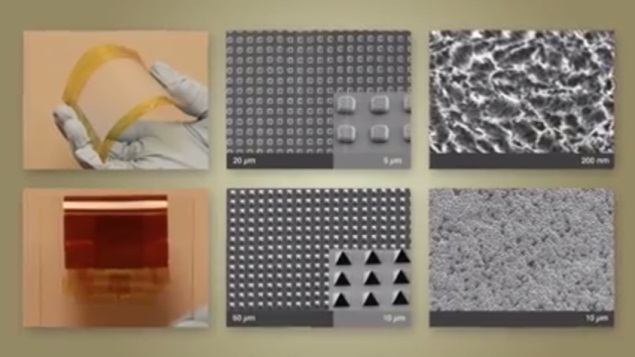- Home
- Others
- Others News
- 'Tribo electric' prototype developed that converts movement into power
'Tribo-electric' prototype developed that converts movement into power

It is an alluring goal of clean, reliable power free from geo-political risks and scientists in the United States said Tuesday it lies within reach, thanks to a smart way to harvest energy called tribo-electricity.
Researchers at the Georgia Institute of Technology said they had built a simple prototype device that converts stop-start movement into power.
Waves, walking and dancing even rainfall, computer keys or urban traffic could one day be harnessed to drive sensors, mobile gadgets or even electricity plants, they contend.
Zhong Lin Wang, a professor of materials science and engineering, described the invention a "breakthrough."
"Our technology can be used for large-scale energy harvesting, so that the energy we have wasted for centuries will be useful," he told AFP by email.
"Tribo-electric" is a modern term with ancient roots from the Greek word for "rub."
Its electricity is created from friction between two substances causing a charge of electrons to be transferred from one to the other.
It commonly happens, for instance, when plastic-soled shoes are in contact with a nylon carpet, causing the snap of static discharge when one's hand touches a metal doorknob.
Because tribo-electric is so unpredictable, it has been generally shunned as a power source.
The preferred method has been magnetic induction a turbine driven by nuclear- or fossil-powered steam or water.
But, in a new study published in the journal Nature Communications, Wang's team said they had overcome key hurdles to converting a haphazardly-generated electrical charge into current.
Their prototype comprises a disc about 10 centimetres (four inches) across, designed to show the potential from a small, portable generator moved by ambient energy.
Inside are two circular sheets of material, one an electron "donor" and the other an electron "receiver," brought together through rotary movement.
If the sheets are separated, one then holds an electrical charge isolated by the gap between them.
Sandwiched between the two discs is a third disc with electrodes, which bridges the gap and helps a small current to flow.
At a top speed of 3,000 revolutions per minute, the device generated 1.5 watts.
This gave it an energy efficiency of 24 percent, three times greater than piezoelectric, the previously best source of mechanical electricity harvesting and as efficient as magnetic-induction turbines.
It can run on a gentle wind or tap water, or "random jerky motions," including human movement, to provide the rotation, Wang said.
"As long as there is mechanical action, there is power that can be generated."
The prototype used copper for the rotator and gold for the electrodes in lab tests, but these could easily be substituted for low-cost synthetics, he said.
The team is working on ways to scale up tribo-electric energy for harvesting power from the ocean.
For the latest tech news and reviews, follow Gadgets 360 on X, Facebook, WhatsApp, Threads and Google News. For the latest videos on gadgets and tech, subscribe to our YouTube channel. If you want to know everything about top influencers, follow our in-house Who'sThat360 on Instagram and YouTube.
Related Stories
- Galaxy S24 Series
- MWC 2024
- Apple Vision Pro
- Oneplus 12
- iPhone 14
- Apple iPhone 15
- OnePlus Nord CE 3 Lite 5G
- iPhone 13
- Xiaomi 14 Pro
- Oppo Find N3
- Tecno Spark Go (2023)
- Realme V30
- Best Phones Under 25000
- Samsung Galaxy S24 Series
- Cryptocurrency
- iQoo 12
- Samsung Galaxy S24 Ultra
- Giottus
- Samsung Galaxy Z Flip 5
- Apple 'Scary Fast'
- Housefull 5
- GoPro Hero 12 Black Review
- Invincible Season 2
- JioGlass
- HD Ready TV
- Laptop Under 50000
- Smartwatch Under 10000
- Latest Mobile Phones
- Compare Phones
- Huawei Pura 70 Pro
- Huawei Pura 70
- Vivo V30e
- Itel Super Guru 4G
- Huawei Pura 70 Pro+
- Huawei Pura 70 Ultra
- Tecno Camon 30 Premier 5G
- Motorola Edge 50 Fusion
- Asus ZenBook Duo 2024 (UX8406)
- Dell Inspiron 14 Plus
- Realme Pad 2 Wi-Fi
- Redmi Pad Pro
- Cult Shock X
- Fire-Boltt Oracle
- Samsung Samsung Neo QLED 8K Smart TV QN800D
- Samsung Neo QLED 4K Smart TV (QN90D)
- Sony PlayStation 5 Slim Digital Edition
- Sony PlayStation 5 Slim
- Voltas 1.5 Ton 3 Star Split AC (183 Vectra Elegant 4503545)
- Hitachi 1.5 Ton 5 Star Inverter Split AC (RAS.G518PCBISF)
-
 Xiaomi 14 Series 'AI Treasure Chest' With Several AI Tools in Testing, Could Debut This Year: Report
Xiaomi 14 Series 'AI Treasure Chest' With Several AI Tools in Testing, Could Debut This Year: Report
-
 Redmi Note 13 5G Series HyperOS Update Based on Android 14 Begins Rolling Out in India
Redmi Note 13 5G Series HyperOS Update Based on Android 14 Begins Rolling Out in India
-
 YouTube Reportedly Rolling Out Support for 8K Resolution Videos on the Meta Quest
YouTube Reportedly Rolling Out Support for 8K Resolution Videos on the Meta Quest
-
 Lenovo Yoga Slim 7 (2024) Design Spotted in Leaked Renders; Could Debut as First Snapdragon X Elite Laptop
Lenovo Yoga Slim 7 (2024) Design Spotted in Leaked Renders; Could Debut as First Snapdragon X Elite Laptop












